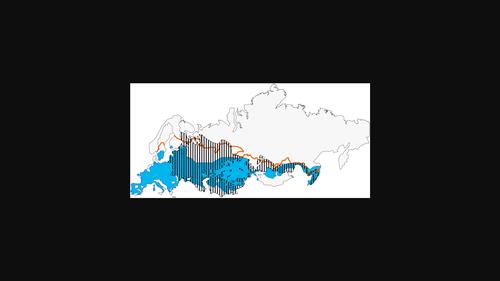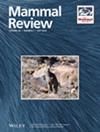The wild boar Sus scrofa in northern Eurasia: a review of range expansion history, current distribution, factors affecting the northern distributional limit, and management strategies
IF 4.4
2区 生物学
Q1 ECOLOGY
引用次数: 8
Abstract
- The wild boar Sus scrofa is one of the most widely distributed large mammal species in the world, existing on all continents except Antarctica. In the late 20th Century, its geographical range expanded naturally and through intentional releases. Despite the environmental, social, and economic importance of the wild boar, its current distribution in northern Eurasia remains uncertain, and the factors that limit and promote expansion in northern ecosystems are unknown.
- We aimed to summarise the history of wild boar range expansion and current distribution in the countries of northern Eurasia. We also assess the relative importance of climate (both harshness and warming), habitat (both current diversity and possible change), predators, releases, supplementary feeding, and hunting in limiting or promoting the distribution and range expansion of the species. We review hunting management and other regulations that may affect further northward expansion.
- Information on wild boar expansion and distribution was collated from available scientific publications, official statistics, volunteer reports, and expert knowledge. The effects of natural factors (climate harshness, habitat variation, predators) and anthropogenic factors (climate warming, habitat change, releases, supplementary feeding, hunting) on wild boar distribution were assessed using estimates (scores) provided by experts from the target regions.
- The wild boar in Europe is distributed up to 64°N. In Asia, the northern distributional limit is up to 61°N. The species' northern distributional limit is further north in the west than in the east of the geographic range.
- Experts regarded climate harshness, habitat, and hunting as the most important factors limiting wild boar distribution. Important factors that promote the expansion of the wild boar's range include climate warming and supplementary feeding.
- Our analysis of the official approaches to wild boar management suggests that the northern Eurasian countries do not have a united approach to the challenge of wild boar expansion. Collaboration between managers, policymakers, and researchers is needed for monitoring the wild boar distribution and range expansion throughout northern Eurasia. This data collection is especially important now, as parts of Europe and Asia are facing the challenge of African swine fever as well as other human–wildlife conflicts related to increasing wild boar populations.

欧亚大陆北部野猪:范围扩张历史、当前分布、影响北部分布极限的因素和管理策略综述
野猪(Sus scrofa)是世界上分布最广泛的大型哺乳动物之一,存在于除南极洲以外的所有大陆。在20世纪后期,它的地理范围自然扩大,并通过有意的释放。尽管野猪在环境、社会和经济方面具有重要意义,但其目前在欧亚大陆北部的分布仍不确定,限制和促进北部生态系统扩张的因素尚不清楚。我们的目的是总结野猪范围扩大的历史和目前分布在欧亚大陆北部的国家。我们还评估了气候(包括严酷和变暖)、栖息地(包括当前的多样性和可能的变化)、捕食者、释放、补充喂养和狩猎在限制或促进物种分布和范围扩大方面的相对重要性。我们审查了狩猎管理和其他可能影响进一步向北扩张的法规。从现有的科学出版物、官方统计数据、志愿者报告和专家知识中整理了野猪扩张和分布的信息。利用目标区专家提供的评分,评估自然因素(气候严酷、栖息地变化、捕食者)和人为因素(气候变暖、栖息地变化、放养、补充喂养、狩猎)对野猪分布的影响。欧洲野猪分布在北纬64°以北。在亚洲,北分布极限在北纬61°。该物种的北部分布界限在西部比在地理范围的东部更北。专家认为,气候严酷、栖息地和狩猎是限制野猪分布的最重要因素。促进野猪活动范围扩大的重要因素包括气候变暖和补饲。我们对野猪管理的官方方法的分析表明,欧亚北部国家没有统一的方法来应对野猪扩张的挑战。管理人员、政策制定者和研究人员之间需要合作,以监测整个欧亚大陆北部野猪的分布和范围扩张。由于欧洲和亚洲部分地区正面临非洲猪瘟的挑战,以及与野猪数量增加有关的其他人类与野生动物冲突,这些数据收集现在尤为重要。
本文章由计算机程序翻译,如有差异,请以英文原文为准。
求助全文
约1分钟内获得全文
求助全文
来源期刊

Mammal Review
生物-动物学
CiteScore
12.20
自引率
4.10%
发文量
29
审稿时长
>12 weeks
期刊介绍:
Mammal Review is the official scientific periodical of the Mammal Society, and covers all aspects of mammalian biology and ecology, including behavioural ecology, biogeography, conservation, ecology, ethology, evolution, genetics, human ecology, management, morphology, and taxonomy. We publish Reviews drawing together information from various sources in the public domain for a new synthesis or analysis of mammalian biology; Predictive Reviews using quantitative models to provide insights into mammalian biology; Perspectives presenting original views on any aspect of mammalian biology; Comments in response to papers published in Mammal Review; and Short Communications describing new findings or methods in mammalian biology.
 求助内容:
求助内容: 应助结果提醒方式:
应助结果提醒方式:


